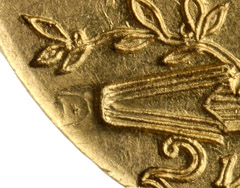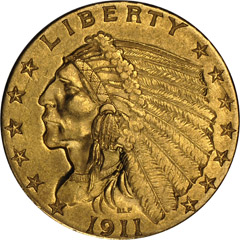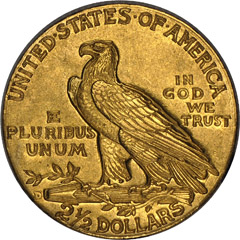Counterfeit Detection: Chased Mintmark 1911-D Quarter Eagle
Posted on 11/8/2011
There are a number of methods used by counterfeiters to add a mintmark to a coin, but probably the crudest is called “chasing.” Rather than take a mintmark from one coin and glue, solder or emboss it to another, the counterfeiter will use a metal tool to sculpt a mintmark out of the coin’s surface. As a result, there will be prominent tool marks in the field nearby and the mintmark will usually be malformed. This method is most frequently used to alter digits in a date, such as an 8 to a 3, and it is rather unusual to see a chased mintmark.
The 1911-D is the key Indian Head quarter eagle with a mintage of just 55,680 pieces, by far the lowest in the series. According to the NGC US Coin Price Guide, even in circulated grades the 1911-D is worth thousands of dollars. The Philadelphia Mint 1911 quarter eagle, on the other hand, is one of the most common dates in the series, and boasts a mintage of more than 700,000 coins. By adding a mintmark to the common P-mint issue, the counterfeiter could realize a huge profit.

When you encounter a rare or better date coin, however, you should always look closely, especially at the date and mintmark. On this piece, the added D mintmark stands out like a sore thumb. The mintmark is too thick and the serifs are incorrectly sized. Many genuine 1911-D quarter eagles have a weakly defined mintmark that blends into the field, so the softly detailed D on this specimen is not necessarily diagnostic, but taken with the other flaws this serves as additional evidence. Examined under a loupe it becomes obvious that the mintmark was carved out of the surrounding field. Although this is not an alteration that collectors will often see, it is always good to be vigilant for new or different types of deception.
Stay Informed
Want news like this delivered to your inbox once a month? Subscribe to the free NGC eNewsletter today!


